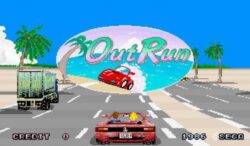OutRun – the state of theart in 1986 video games (pic: Sega)
A reader details why he considers 1986 to be his favourite year in video game history, thanks to titles like OutRun, Bubble Bobble, and Ikari Warriors.
I’ve read the GameCentral pages for many years and often see people state what a great year for gaming it has been. In many cases this has been the year that we were in, and I have often wondered with hindsight, if that year was as good as that person thought. It was also the subject of a letter in a recent Games Inbox, along with some good arguments in the Underbox, from Floyd Hamilton, that 1998, amongst others, were also strong contenders.
I’d say 1998 is a good call too, Floyd. It also got me thinking as to what year I would choose as my own greatest gaming year and after some consideration, a little bit of heart searching, and some help from Google I’m going to give that accolade to the year 1986. Please allow me to give some context to that decision.
1986 was the year of the Chornobyl nuclear disaster and the fear of radiation contaminating large parts of Europe; the space shuttle Challenger exploding shortly after take-off above Cape Canaveral; Ronald Reagan and Mikhail Gorbachev discussing nuclear disarmament; the signing of the Nuclear Forces Treaty by the USA and USSR; and Prime Minister Margaret Thatcher opening the final stretch of the M25.
I was 14 years old, technology was advancing at a rapid pace, people had computers in their homes and what you could experience in an arcade was lightyears away from what a Commodore or Spectrum could offer. This still didn’t stop us forking out our hard earnt paper round money on arcade conversions for our home computers.
It was usually the case that the arcade conversions sold you the dream of the arcade game through the box art but the most you could hope for was a conversion which captured the spirit of the gameplay and bore a passing resemblance to the original source material. This was an exciting time, but not quite as exciting as coming home from a day at school and seeing that your parent’s had just bought a new Hi-Fi with a twin tape deck. This opened up a whole new world…
Going to see the latest film at the cinema was a big event. The most hype a film received then was maybe a poster outside the cinema and three photographs from the film beneath it a week before its release or Barry Norman reviewing it on his Film 86 TV show. This was the year Ferris Bueller took his day off, Ripley kicked some serious butt on a bug hunt, Maverick made us all want to be his wingman and not lose that loving feeling, and we discovered the harsh realities of the Vietnam War through Oliver Stone’s Platoon.
Music was bought on cassette or vinyl, or you could record straight from the radio on to a tape. In the 1986 singles charts Wham took us to The Edge of Heaven, Berlin wanted to Take our Breath Away, Europe started their Final Countdown, a-ha were telling us how The Sun Always Shines on TV, and Lionel Ritchie was Dancing on The Ceiling. The album chart of 1986 gave us classics like Michael Jackson’s Thriller, Queen was showing us their Kind of Magic, Run DMC were Raising Hell, Madonna was True Blue, and Kenny Loggins was taking us into the Danger Zone as part of the Top Gun soundtrack.
In a time before the internet, we would eagerly await the next month’s copy of Zzap64! or Crash magazine to appear on the local newsagent’s shelf. Then feverishly thumb through the pages to see which games we would buy that month, the ones to avoid, the ones your friends would laugh at you for buying when it reviewed badly, and new games to get excited about. No internet spoilers just information drip fed monthly and spread by word of mouth in the school playground.
This paints a small picture of the cultural background that we were living against when the following games were first experienced. The culture of the film and music industry, as well as wider world events, heavily influenced the games scene at the time.
In the 1980s there was an enormous difference between the experience of the arcades and how you played at home. Sega ruled the arcades with their super sprite scaler technology. In 1986 Sega gave us OutRun and driving games would never be the same again. OutRun is probably the best known game of the year and some would argue that that is a good enough reason to choose 1986 alone. However, 1986 also introduced us to plenty of other familiar games, such as Taito’s Bubble Bobble, which is immensely playable to this day.
Sega’s Wonder Boy, with his fruit collecting and skateboarding platform antics; SNK’s Ikari Warriors, a one or two-player vertical scrolling shooter in the vein of Capcom’s Commando but with more than a passing homage to Rambo; Konami’s follow up to Gradius/Nemesis in the form of Salamander/Lifeforce, depending upon the region you played it in.
Four people playing elf, warrior, wizard, and Valkyrie crammed around a cabinet was still a thing, as Atari released Gauntlet 2. No arguing who was who this time, as you could all just be different coloured elves if you wished. The round, spinning, cabinet of Konami’s WEC Le Mans 24 stood out as well, for having amazing graphics. Objects passing overheard in racing games still wasn’t that common, so racing under the Dunlop branded bridge on the Le Mans circuit, with a beautiful cloudy blue sky or sunset above it, was quite spectacular.
1986 also gave us the evolution of Atari’s Breakout in the form of Taito’s Arkanoid; more multiplayer fun in Midway’s Rampage; Atari’s multi-steering wheel wielding Super Sprint; and another super sprite scaler, with Sega’s Enduro Racer complete with a dirt bike to take the arcade experience to another level.
1986 was a big year for home arcade conversions. I had a Commodore 64 but also had several Sinclair Spectrum 48K-owning friends. This year Tecmo’s Bomb Jack, Capcom’s 1942 and Ghosts ’N Goblins, Konami’s Green Beret (aka Rush ‘N Attack), and Atari’s Gauntlet were all given the home conversion treatment with reasonable success.
It wasn’t just all arcade conversions though, as there were also many original games released, with Ocean’s Batman on the Spectrum 48K showing Ultimate Play the Game they weren’t the only ones who could make great isometric games. They also made the Amstrad CPC464 version look even better with an improved colour palette.
After Raid Over Moscow, Bruce and Roger Carver were introducing us to the slightly more sedate world of Leaderboard Golf; Archer MacLean allowed us to beat the hell out of each other with International Karate; and Andrew Braybrook gave us the brilliant horizontal shoot ‘em-up Uridium.
Monty On The Run was released on C64 and the Spectrum in 1985, however it was released in 1986 on the Amstrad CPC464 – so I feel it is only right to give it a mention, as it was the pinnacle of the series, which also included a Sinclair C5 electric car in the game if memory serves me correctly.
The home console market was in its infancy. Nintendo’s NES introduced us to Super Mario Bros. and arcade conversions of Donkey Kong and Gradius in the September of 1986. It’s competition, the Sega Master System, wasn’t released until August 1987.
I look back on this period as being a fantastic time to be a gamer. A new frontier for companies and individuals to try something new and not have to risk many millions of pounds, and years of hard work, on a single title. It’s important not to forget that many games were written by either individuals or small groups of people in a matter of weeks. Some of whom went on to be well known figures in the games industry.
The games we played were also a reflection of the times and events going on in the real world around us, such as the Frankie Goes To Hollywood game (released in 1985). Yu Suzuki’s concept for OutRun is based around the Cannonball Run films. Many of the original games were a social commentary of the times we lived in, and these gave us an informal education and shaped part of our perception of the world we were growing up in.
Today’s games industry has its own identity, which influences the media which so obviously shaped its formative years. Music from games is readily available to buy on physical media or via streaming, television shows and films are based on games and books extend a games universe to enrich the lore of the original games.
More: Trending
Gaming has come a long way since 1986, many of the games released then are still extremely playable today. I appreciate some readers are probably thinking that some of the games I have mentioned are not in the same league as a Zelda, Mario, Skyrim, or GTA, amongst many others, and I would agree.
However, I have tried to paint a wider image of the time, what was happening in the world, and the influences of other media on gaming to give a bit of background to my choice. For me it is this wider picture, as well as the innovation in the gaming industry, the simple but clever game design, and gameplay mechanics that make 1986 my greatest year of gaming.
It will be interesting to hear other GC reader’s nominations.
By reader Rose Tinted Glasses
The reader’s features do not necessarily represent the views of GameCentral or Metro.
You can submit your own 500 to 600-word reader feature at any time, which if used will be published in the next appropriate weekend slot. Just contact us at gamecentral@metro.co.uk or use our Submit Stuff page and you won’t need to send an email.
MORE : Xbox fans get access to over 1,000 retro games with new Antstream Arcade app
MORE : Retro Call Of Duty games become Xbox best-sellers thanks to surprise update
MORE : Pixel Ripped 1978 review – retro gaming in VR
Follow Metro Gaming on Twitter and email us at gamecentral@metro.co.uk
To submit Inbox letters and Reader’s Features more easily, without the need to send an email, just use our Submit Stuff page here.
For more stories like this, check our Gaming page.
Sign up to all the exclusive gaming content, latest releases before they’re seen on the site.
This site is protected by reCAPTCHA and the Google Privacy Policy and Terms of Service apply.
A reader details why he considers 1986 to be his favourite year in video game history, thanks to titles like OutRun and Ikari Warriors.





